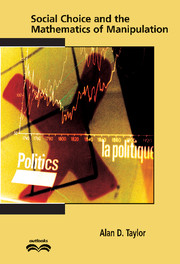2 - An Introduction to Manipulability
Published online by Cambridge University Press: 07 December 2009
Summary
Set Preferences and Manipulability
It has long been known that a voter can sometimes achieve a preferred election result by casting a ballot that misrepresents his or her actual preferences. Over a century ago, C. L. Dodgson referred to a tendency of voters to “adopt a principle of voting which makes it more of a game of skill than a real test of the wishes of the electors” (Black, 1958, p. 232). Dodgson went on to say that in his opinion, it would be “better for elections to be decided according to the wishes of the majority than of those who happen to have most skill at the game” (Black, 1958, p. 233).
The most famous manipulability quote in the history of social choice, however, predates Dodgson by a century or so. It was Jean Charles de Borda's famous reply to a colleague who had pointed out to him how easy it was to manipulate his (Borda's) method of marks (i.e., the Borda count). “My scheme,” Borda replied, “is only intended for honest men!” (Black, 1958, p. 182).
Alas, the practice of manipulation today is not restricted to men or women we would consider dishonest. For example, in his 1986 book, The Art of Political Manipulation, the late William H. Riker (considered by many to be the intellectual founding father of positive political theory) provides a dozen stories that illustrate the extent to which
politicians are continually poking and pushing the world to get the results they want. The reason they do this is they believe (and rightly so) that they can change outcomes by their efforts.[…]
- Type
- Chapter
- Information
- Social Choice and the Mathematics of Manipulation , pp. 37 - 59Publisher: Cambridge University PressPrint publication year: 2005



